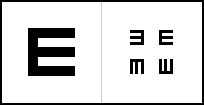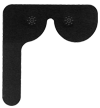
|
|
Objectives
Distance Visual Acuity
Distance Visual Acuity
Distance visual acuity (DVA) is tested to gain an understanding of the degree of vision loss. It does not indicate how well a person uses vision but is a standard measurement. Vision loss can be described in the following categories
Amount of Visual Loss Visual Acuity None to Slight
6/6 - 6/18
Moderate
<6/18 - 6/60
Severe
<6/60 - 3/60
Profound
<3/60
Measuring visual acuity is testing the smallest symbol that can be recognised.
It does not matter if a person cannot read, vision can be tested using E symbols. Other tests can be used if you have them. Use the test that is easiest for the person you are testing.
Record two numbers for the measure of distance visual acuity. The first number is the distance used for testing. Usually this is either 6, 3 or 1 metre. The second number is the size of the symbol read. The larger the second number, the larger the size of the symbol thus the worse the vision.
The sizes 60 and 18 are the distances in metres that the shapes can be read by a person with normal vision. For example the '24' symbol could be read at 24 metres by someone with normal vision.
Examples
6/18
6/60
3/60
In some countries, distance for testing is measured in feet. 6 metres is approximately equal to 20 feet.
Visual acuities are recorded as:
20/20 = 6/6
20/60 = 6/18
20/200 = 6/60
Simulation Help
The E Chart
This simple vision screening test has been designed for use for older people of all abilities including those with speech, cognitive and motor impairments. It can easily be used with people who are not fluent with English. People with advanced levels of dementia may have some difficulties with the test but it should be tried if at all possible.
The E Chart is part of the Low Vision Kit

Getting ready for the eye test
Preparing for the Eye Test Movie
1,027KB
Before commencing the test:
- select the most recent pair of distance glasses
- ensure the best lighting with minimum glare and distractions
- measure a three metre distance from the back of the chair to the test card
A demonstration of the E chart test for distance visual acuity
3,065KB
This short movie demonstrates the E chart test
While completing the test:
- Start test with middle level (6/18)
- Ensure at least 3 out of 4 figures are correctly identified
- If not, test largest size (6/60) or
if so, test smaller line (6/12)If a person cannot see the chart at all, test whether they can perceive light. This is then recorded as either PL (Perception of Light) or NPL (No Perception of Light)
The Pinhole Mask
A special test using the pinhole mask can identify those people with poor vision who may need spectacles to improve their vision. The mask has very small holes in the area in front of the pupil. People who have visual acuity improved with the pinhole should be referred for examination and treatment by an eye care practitioner
1,674KB
Which is considered poorer vision 6/6 or 20/20?
Which is considered poorer vision 6/18 or 6/60?
At what distance were these visual acuities measured? (3/60, 20/60, 6/6)?
|
|
| Visual Communication Unit |



